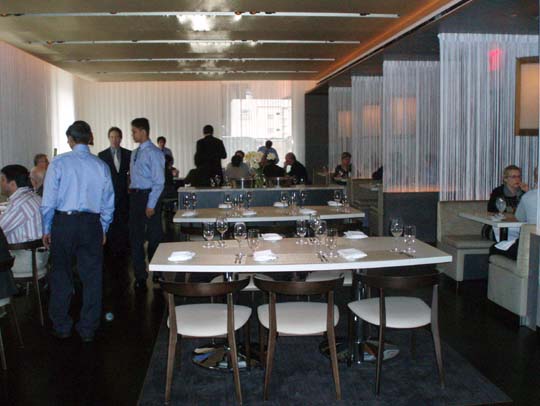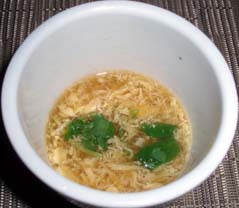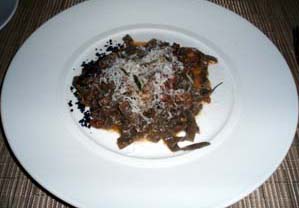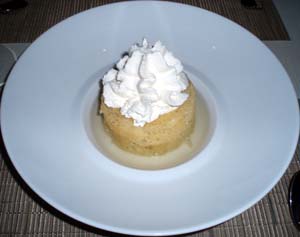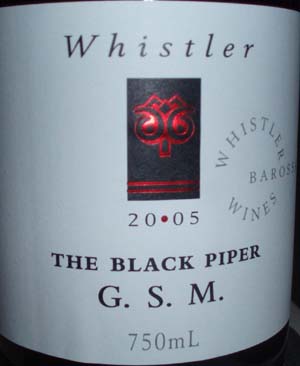Brasserie Ruhlmann
 Saturday, May 12, 2007 at 10:48PM
Saturday, May 12, 2007 at 10:48PM  Brasserie Ruhlmann got on my “ought-to-try” list after I heard that Laurent Tourondel had taken over the kitchen. Perhaps I ought to have been suspicious.
Brasserie Ruhlmann got on my “ought-to-try” list after I heard that Laurent Tourondel had taken over the kitchen. Perhaps I ought to have been suspicious.
Laurent Tourondel has spread himself thinner than goose liver pâté. He has four other Manhattan restaurants in his BLT franchise (BLT Steak, BLT Prime, BLT Fish, and BLT Burger), a fifth opening this summer (BLT Market), and BLT Steak outposts in two other cities. He’s built up that empire in just a shade over three years, so he can’t be spending much time in any of his kitchens.
Brasserie Ruhlmann was a quick rescue job. The restaurant opened in January 2006 with another executive chef, and Tourondel was named to the post just three months later. I assume Tourondel got a tidy consultant’s fee to design a standard-issue French brasserie menu that he could hand over to a chef de cuisine, and never think about again. His name is on the menu and his cookbook prominently displayed, but there’s none of the inspiration that make the BLT restaurants so impressive. (Update: Tourondel has yet another offspring: BLT Steak in the Westchester Ritz-Carlton.)
Brasserie Ruhlmann is named for the art deco furniture designer Émile-Jacques Ruhlmann. Owner Jean Denoyer is a Ruhlmann collector himself, and he spent $5 million building out the spectacular space on Rockefeller Plaza, where the art deco theme is always at home. Denoyer knows a little something about restaurants too, as he also owns the Michelin-starred La Goulue on the Upper East Side (among other places).
Alas, the kitchen just goes through the motions. You’ll have a satisfactory meal at Brasserie Ruhlmann, but nothing you can’t have at many other French brasseries around town, or indeed at La Goulue, where the food is better, and the atmosphere feels far less like a tourist trap.
We arrived at around 8:00 p.m. on a Saturday night, with the restaurant nearly deserted. It seemed like a nice evening, so we decided to sit outdoors. Drinks—a sidecar for me, a whiskey sour for my girlfriend—took twenty minutes to arrive. The manager explained that they’d never heard of a sidecar, and had to look it up. After all that time, they served my girlfriend whiskey straight-up, rather than a whiskey sour. We sent it back.
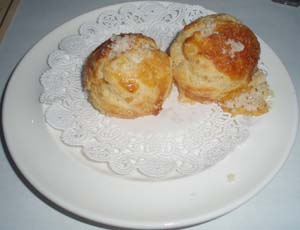 By now, it was 8:25. Though we had only just started sipping our cocktails, naturally they were keen to take our wine and food order instantly, but we were having none of that. When we finally did order, the wine came promptly, but the waiter struggled to uncork it. After a minor skirmish, he managed to push the cork into the bottle. With a sheepish look, he disappeared.
By now, it was 8:25. Though we had only just started sipping our cocktails, naturally they were keen to take our wine and food order instantly, but we were having none of that. When we finally did order, the wine came promptly, but the waiter struggled to uncork it. After a minor skirmish, he managed to push the cork into the bottle. With a sheepish look, he disappeared.
Meanwhile, the rains had come, so we headed inside. A short while later (it was now 9:00), he returned to our new table with the wine in a decanter—“very well filtered,” he assured us.
Complain all you want about Laurent Tourondel, but the bread service is always superb at his restaurants. Gougères (above, right) were perhaps the most original item we had at Brasserie Ruhlmann.
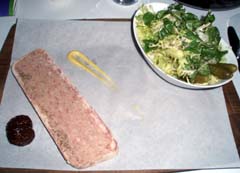
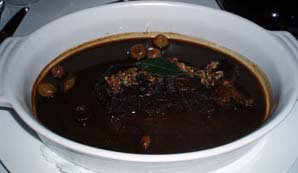
Country Pâté (left); Beef Shortribs Bourguignonne (right)
Country Pâté ($12) was competently prepared, although fairly ordinary. Beef Shortribs Bourguignonne ($28) were served in a generous portion, though the sauce was a bit heavy. (The photo doesn’t do it justice—beef seldom photographs well.)
After the comic mishaps with the drinks, the rest of the evening’s service was just fine. On principle, we thought that the drinks should have been comped—but they weren’t. The restaurant was nearly empty while we were there. It is probably busier and livelier at lunch, as at dinner time there’s usually no reason to be in the area. So far, it doesn’t look like Brasserie Ruhlmann will change that.
Brasserie Ruhlmann (45 Rockefeller Plaza, 50th Street between Fifth & Sixth Avenues, Rockefeller Center, West Midtown)
Food: Satisfactory
Service: Mediocre
Ambiance: Good
Overall: Satisfactory












